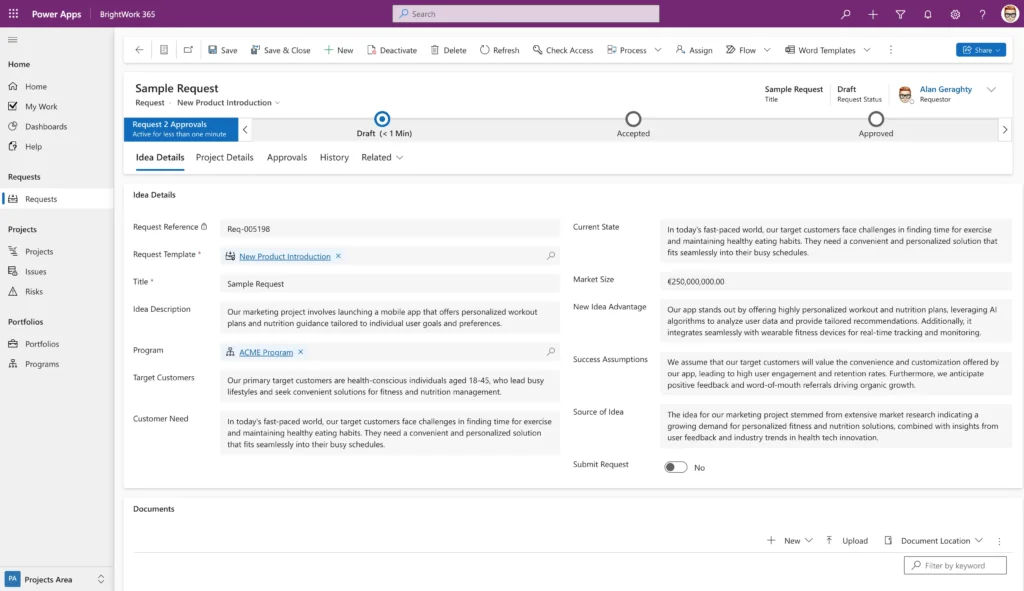Why is Project Prioritization Important?
Projects address business problems such as creating something new, improving processes, reducing risks, or increasing revenue.
With limited resources to deliver strategic goals, organizations use a prioritization system to manage new project requests rigorously.
Project prioritization involves aligning projects with goals while ensuring resources are allocated to tasks or projects that offer the most value.
Unfortunately, many organizations suffer from “initiative overload,’’ where too many projects run simultaneously. This situation wastes resources, causes departmental conflicts, and leads to high employee turnover.
This article examines project prioritization from two perspectives: an existing project portfolio and managing new project requests.
What are the Causes of Project Overload?
Project request management is integral to project portfolio management (PPM). PPM helps organizations define long-term goals that shape project selection
Simply put, understanding a company’s direction informs decisions about project approval, timelines, and team assignments. A clear strategic vision drives project prioritization and selection.
Without a structured prioritization framework, organizations lose control over projects and resources very quickly, which can impact project success rates. There are a few reasons why organizations struggle with project overload.
1. Impact Blindness
As noted in Harvard Business Review, many organizations have no way to identify, measure, and manage the impact of projects on teams and managers.
More work is simply added to the backlog, with no insight into the consequences for important projects and resource allocation.
2. Planning in Silos
When projects are planned by individual departments, priorities are determined in isolation from the overall vision of the organization.
Projects are launched without considering how the work or project deliverables will impact other areas of the business.
In addition, resources are stretched across multiple competing projects, answering to numerous managers.
3. Poor Problem Definition
Sometimes, projects are launched to solve a surface problem, not the root cause. This leads to an ongoing pipeline of short-term fixes.
4. Resources
In some cases, multiple projects are approved without the necessary project budget or resources. In other instances, organizations may lower headcount without reducing the work.
Either way, teams struggle to do more with less, leading to project and budget overruns.
5. Initiative Inertia
Many organizations can’t or won’t end failing projects. There are many reasons for this, such as:
- ‘Sunk-cost fallacy’ – is a tendency to continue with work due to the time, money, and resources already invested in it.
- The lack of a ‘sunset clause’ – a process for ending projects by a certain date.
6. Low-Risk Appetite
Approving too many projects can indicate a risk-averse culture. If senior executives worry about missing the latest market opportunity or upgrading to new technology, the project pipeline becomes quite full.
In contrast, companies such as Apple, Amazon, and Ikea maintain a narrow focus, driven by a limited number of carefully selected projects.
Financial Impact of Poor Project Practices
The cost of ineffective project management highlights the urgency of good prioritization strategies. According to the Project Management Institute:
- Poor project management practices waste around $2 trillion dollars per year.
- Organizations lose 9.9 percent of every dollar due to poor project performance.
- 31% of projects do not meet their goals.
- 35% of projects are not aligned with strategic goals.
- 52% of projects experience scope creep.
Poor project performance is expensive, making the project prioritization process even more urgent. Project requirements must be carefully defined from the outset to avoid these issues and ensure resources are allocated effectively.
Importance of Structured Project Prioritization
Defining clear project prioritization criteria enables teams to mitigate waste and focus on high-impact work.
Organizations can use a prioritization matrix or a scoring model to rank initiatives based on project costs, potential financial returns, and expected outcomes. Taking a structured approach to project prioritization makes it easy to:
- Align projects with strategic goals.
- Plan projects with a holistic view of the pipeline.
- Sequence projects.
- Manage resources more effectively.
- Help teams understand where to prioritize work and focus their time.
Manage Your Project Pipeline with Microsoft 365
Watch a demo of BrightWork 365 project and portfolio management templates for Microsoft 365, Power Platform, and Teams.

4 Ways to Prioritize Your Existing Project Portfolio
Evaluating the current situation and collaborating with senior management helps establish priorities. Use this analysis to refine your pipeline and set criteria for maintaining the portfolio in the future.
Below are project prioritization techniques to help you get an existing project portfolio under control.
1. Assess the Portfolio
Firstly, you need to understand the current state of your project portfolio. Gather key information on the following:
- Number of active projects.
- The status of these projects.
- Business case and strategic alignment of each project.
- Resource allocation and budgets.
If your organization is using project portfolio management software, gathering this information should be easy to access.
If not, collaborate with project managers and senior executives to collect the data. Next, review the pipeline of proposed projects:
- What projects are planned?
- When will these projects start?
- Are resources evenly distributed?
- Is the business case for each project still applicable?
- Are there any dependencies between projects?
- What is the cost of doing or not doing a project?
2. Establish Priorities
Work with senior management and departments to identify priorities for the entire company. Prioritize projects that should align with the organization’s strategic goals.
If these goals are not clearly defined, you can use the following questions to guide the conversation:
- What is the purpose of the organization?
- How should we pursue this purpose?
- What is our vision?
- What matters most to the organization now and in the future?
- What are our priorities now and over the next two to five years?
Focus discussions on what drives projects in your organization. Projects are often used to:
- Gain competitive advantage
- Save money
- Streamlines processes
- Meet regulatory requirements
- Reduce risk
- Improve quality.
Aligning Departmental Goals
Departments interpret business goals differently, so it’s important to understand when and why projects are initiated. You may even need to develop a shared definition of what a project actually is!
With this information, decide what value looks like to your organization. Consider the expected impact of a project, how ROI is measured, and the best use of resources. Assess how risk is evaluated. Gather input from all departments to ensure a balanced approach.
3. Update the Portfolio
With agreement from senior management and project managers, review the portfolio to decide which projects to continue, pause, or end. Introduce a project prioritization method, such as the Eisenhower Matrix or a weighted scale. For example,
- 1 = very low
- 2 = low
- 3 = medium
- 4 = high
- 5 = critical.
For teams using Microsoft 365, the Project Request Management app in BrightWork 365 simplifies this process easily with automated workflows.

Once the portfolio is updated, let relevant managers and departments know if a project is paused or canceled and why. It’s important for teams to understand the limitations on the number of projects that can be delivered successfully.
4. Maintain the Portfolio
Next, we’ll explore key questions for evaluating new project requests. For now, our focus is on adding some larger checkpoints to the portfolio. These include:
- Creating a sunset clause for every project. This is an end date for funding and resource allocation to prevent projects from rolling on for too long.
- Requiring managers to reapply for project funding and resource allocation during the annual planning cycle.
- Using real-time project management tools, cross-project reports, and dashboards to monitor project execution.
- Introducing a standard intake form for new project requests to standardize and improve the selection process.
- Limiting the number of projects assigned to a project manager at any given time.
- Mixing short and long-term projects to free up resources and deliver goals quickly.
9 Questions to Prioritize New Project Requests
With a balanced, strategic project portfolio in place, it’s time to improve project selection. Ideally, this process should be facilitated by project management software to help with the following:
- Collecting new project requests.
- Sending automated updates to a requester when the project is approved or rejected.
- Creating a new project site for approved requests.
Here are some questions to ask when evaluating a new project request:
- What problem will this project fix?
- Is there data to support the desired outcome?
- What resources are needed to complete this work?
- Who will be responsible for the final deliverable, such as a new document management system?
- Will you need to hire new employees or outsource part of the work?
- How does the cost of resources compare to the proposed business value of the project?
- Who are the key project stakeholders?
- What happens if we don’t deliver this project?
- Is there a sunset clause in place?
Mastering Prioritization for Project Success
Prioritizing the project portfolio management process is an opportunity to deliver better projects and become more focused.
As Steve Jobs said:
“People think focus means saying yes to the thing you’ve got to focus on. But that’s not what it means at all. It means saying no to the hundred other good ideas that there are. You have to pick carefully. I’m actually as proud of the things we haven’t done as the things I have done. Innovation is saying “no” to 1,000 things.”
Standardize your project management processes with Microsoft 365
Watch a demo of BrightWork 365 project and portfolio management templates for Microsoft 365, Power Platform, and Teams.

